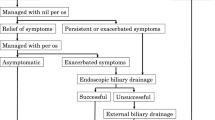Abstract
The role of endoscopic retrograde cholangiopancreatography (ERCP) in the preoperative assessment of anomalous pancreaticobiliary junction was retrospectively evaluated in 74 consecutive patients (19 males and 55 females; aged 0–80 years). Sixty-three patients had congenital biliary dilatation and 11 did not. Type classification of congenital biliary dilatation was possible by ERCP alone in 45 patients (71%). The main causes of classification failure were previous bilio-enteric anastomosis and restriction of postural changes during ERCP due to general anesthesia in pediatric patients. Classification of anomalous junction was possible in 69 patients (93%). Technical difficulty in ERCP caused classification failure in 5 patients. Neoplastic lesions were found in 12 patients (16%) and all but 1 were correctly diagnosed by ERCP. We conclude that ERCP plays an important role in the preoperative diagnosis and type classification of anomalous pancreaticobiliary junction and congenital biliary dilatation.
Similar content being viewed by others
References
Kimura K, Ohto M, Saisho H, Unozawa T, Tsuchiya Y, Morita M, Ebara M, Matsutani S, Okuda K (1985) Association of gallbladder carcinoma and anomalous pancreaticobiliary ductal union. Gastroenterology 89:1258–1265
Komi N, Takehara H, Kunitomo K (1989) Choledochal cyst: Anomalous arrangement of the pancreaticobiliary ductal system and biliary malignancy. J Gastroenterol Hepatol 4:63–74
Miyano T, Suruga K, Suda K (1981) The choledocho-pancreatic long common channel disorders in relation to the etiology of congenital biliary dilatation and other biliary tract disease. Ann Acad Med 10:419–426
Komi N, Tamura T, Miyoshi Y, Hino M, Yada S, Kawahara H, Udaka H, Takehara H (1985) Histochemical and immunohistochemical studies on development of biliary carcinoma in 47 patients with choledochal cyst: Special reference to intestinal metaplasia in the biliary duct. Jpn J Surg 15:273–278
Mori K, Nagakawa T, Ohta T, Nakano T, Kayahara M, Kanno M, Ueno K, Izumi R, Miyazaki I (1993) Association between gallbladder cancer and anomalous union of the pancreaticobiliary ductal system. Hepatogastroenterology 40:56–60
Chijiiwa K, Tanaka M, Nakayama F (1993) Adenocarcinoma of the gallbladder associated with anomalous pancreaticobiliary ductal junction. Am Surg 59:430–434
Yamauchi S, Koga A, Matsumoto S, Tanaka M, Nakayama F (1987) Anomalous junction of pancreaticobiliary duct without congenital choledochal cyst: A possible risk factor for gallbladder cancer. Am J Gasroenterol 92:20–24
Todani T, Watanabe Y, Naruse M, Tabuchi K, Okajima K (1977) Congenital bile duct cysts: Classification, operative procedures, and review of 37 cases including cancer. Am J Surg 134:263–269
Ishida M, Tsuchida Y, Saito S, Hori T (1970) Primary excision of choledochal cysts. Surgery 68:884–888
Hata Y, Sasaki F, Takahashi H, Tamura M, Ohkawa Y, Saji Y, Kurauchi N, Manabe K, Uchino J (1993) Surgical treatment of congenital biliary dilatation associated with pancreatico-biliary maljunction. Surg Gynecol Obstet 176:581–587
Babbitt DP, Starshak RJ, Clemett AR (1973) Choledochal cyst: A concept of etiology. AJR 119:57–62
Komi N, Udaka H, Ikeda N, Kashiwagi Y (1977) Congenital dilatation of the biliary tract: New classification and study with particular reference to anomalous arrangement of the pancreaticobiliary ducts. Jpn J Gastroenterol 12:293–304
Aoki H, Sugaya H, Simazu M (1987) A clinical study on cancer of the bile duct associated with anomalous arrangements of pancreaticobiliary ductal system. Analysis of 569 cases collected in Japan (in Japanese). Tan to Sui (Biliary Tract and Pancreas) 8:1539–1551
Uchimura M, Waki S, Kida E, Kanda K, Narita K, Maeda S, Soejima H, Okamoto K, Ozaka K (1991) Anomalous arrangement of pancreaticobiliary ductal system and biliary carcinoma (in Japanese). Tan to Sui (Biliary Tract and Pancreas) 12:397–404
Matsumoto S, Tanaka M, Ikeda S, Yoshimoto H (1991) Sphincter of Oddi motor activity in patients with anomalous pancreaticobiliary junction. Am J Gastroenterol 86:831–834
Mitake M, Nakazawa S, Naitoh Y, Kimoto E, Tsukamoto Y, Yamao K, Inui K (1991) Value of endoscopic ultrasonography in the detection of anomalous connections of the pancreatobiliary duct. Endoscopy 23:117–120
Shirai Z, Toriya H, Maeshiro K, Ikeda S (1993) The usefulness of endoscopic retrograde cholangiopancreatography in infants and small children. Am J Gastroenterol 88:536–541
Komi N, Takahara H, Miyamoto H, Hirai T, Kameoka K, Hino M (1982) Pathophysiology of anomalous arrangement of the pancreaticobiliary ductal system: Clinical point of view (in Japanese). J Clin Surg (Tokyo) 37:1775–1780
Author information
Authors and Affiliations
About this article
Cite this article
Yokohata, K., Kimura, H., Naritomi, G. et al. Type classification of anomalous pancreaticobiliary junction by ERCP. J Hep Bil Pancr Surg 1, 236–239 (1994). https://doi.org/10.1007/BF02391073
Received:
Accepted:
Issue Date:
DOI: https://doi.org/10.1007/BF02391073




